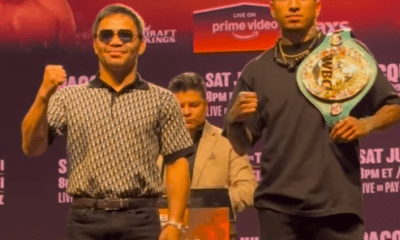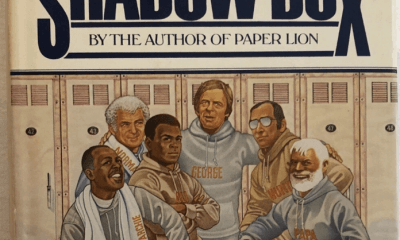Featured Articles
RASKIN’S RANTS: The Real Winners & Losers Of Mares-Agbeko
 If this life were fair, Russell Mora would be sentenced to about ten of those “bordeline” shots that Mares threw at Agbeko’s groin and legs.
If this life were fair, Russell Mora would be sentenced to about ten of those “bordeline” shots that Mares threw at Agbeko’s groin and legs.
One of these days, we’re going to get a highly entertaining fight that ends with one boxer winning deservedly, no controversy, nobody making excuses, nobody filing appeals. But until that day comes, we have fights like Abner Mares vs. Joseph Agbeko to discuss. This week’s dip into the mini-mailbag asks a simple question that allows me to comment extensively on Saturday’s action-packed but ultimately unsatisfying end to Showtime’s bantamweight tournament:
Eric,
Jay Nady, Laurence Cole, and Arthur Mercante Jr. are like the Muhammad Ali, Joe Louis, and Jack Johnson of lousy refereeing, three absolute legends of sucking. But then there is Russell Mora, apparently the Buster Douglas of awful referees. He doesn’t have a consistent track record of sucking to compete with a buffoon like Cole, but for one night, at the peak of his powers, nobody could touch him. This really might have been the worst single-fight performance by a ref I’ve ever seen.
Here’s my question for you: There’s a certain so-called boxing writer on a certain site you used to write for who reviews the weekend in boxing with incredibly lame and obvious picks for “biggest winner” and “biggest loser.” (In the spirit of the last episode of Ring Theory, where you chose not to give sanctioning bodies or bad writers free publicity by stating their names, I won’t state his name either. But I think you know who I’m talking about.) I can promise you right now, this “writer” will tell us Abner Mares is the big winner because he technically won the fight, and Joseph Agbeko is the big loser because he technically lost. So I’m turning to you to think more creatively and tell me who the big winners and losers from this fight REALLY were. Looking forward to what you come up with.
Thanks,
Alex
Alex,
Thanks for the email, it’s an excellent set-up. I’d be more than happy to tell you who the real winners and losers from the Mares-Agbeko fight were:
BIGGEST WINNER: JOSEPH AGBEKO
Agbeko scored huge sympathy points, which sometimes carry a career farther than a simple “W” does. He also earned major respect points by battling through all the low blows and a slow start (I only gave him one of the first six rounds) to rally and do enough to earn the win had he not had the 11th-round knockdown call go against him and had Mares been penalized at least once or twice like he should have been. That 11th round alone might have been a four-point swing; two judges apparently ruled it 10-8 for Mares, but it should have been 10-8 for Agbeko. Bottom line: People will remember that Agbeko fought his ass off, and he’ll be more popular than ever before on account of the fact that he got blatantly screwed.
BIGGEST LOSER: RUSSELL MORA
Not a whole lot of explanation needed here. This was the height of incompetence, compounded by a stubborn streak. When Mora was shown the slo-mo replay of the “knockdown” punch landing squarely on the cup, he was too pig-headedly defensive to earn back a measure of public support by saying, “Boy, you know, now that I see it in slo-mo, yep, that was a low blow. My mistake. I missed it.” His behavior in the interview matched his behavior in the fight; he was locked into a singular mindset, and he just couldn’t accept that it was the wrong one. The “Buster Douglas of awful referees,” as you called him, should probably go eat himself into a diabetic coma and come out of it in two or three years, when this has all blown over.
EVEN STEVEN: ABNER MARES
Mares’ stock goes neither up nor down. He remains a definite top-five bantamweight who can’t quite win definitively against other top-five bantamweights. He’s an entertaining fighter, but we already knew that. I’d estimate he went low about 15 times over the course of the fight (a few of the shots the Showtime crew claimed were low appeared to me to be on the beltline), but he didn’t seem to be fouling on purpose. He was just throwing one borderline shot after another and figuring, “If I’m not going to lose points for it, why stop?” You can’t hold Mora’s ineptitude against Mares. That said, you can’t really call Mares a winner just because he got his hand raised.
OTHER WINNERS: JIM GRAY, AL BERNSTEIN, INSTANT REPLAY ADVOCATES
Gray is a winner because his boorish interview style was directed at the villain of the moment and therefore was well-received by the public for once. Bernstein is a winner because he (a) identified that Mora was blowing it very early in the proceedings, and (b) criticized him in a rational, even reluctant manner, coming off as the genuine pro that he is. And instant-replay advocates win because the 11th-round knockdown would have been easy to reverse between rounds if the powers-that-be in boxing would finally get into the 20th century—you know, now that we’re 11 years into the 21st.
OTHER LOSERS: ADALAIDE BYRD & OREN SHELLENBERGER, BOXING FANS, OSCAR DE LA HOYA
Byrd and Shellenberger are mild losers for their slightly-too-wide 115-111 scorecards (though you could argue they’re winners because Mora’s atrocious officiating made their questionable scoring barely worth mentioning). The fans are losers because they got an unsatisfying result and because an attractive 118-pound opponent for Nonito Donaire failed to emerge (Donaire thumps either Mares or Agbeko). And De La Hoya is a loser for pulling the ol’ tweet-n-delete with a disgusting comment about Showtime’s broadcasters having bet on Agbeko. You would think after getting sued for slander once, Oscar might have learned his lesson. Not so much. Time to put child locks on that Twitter account, Richard.
That wraps up this week’s mini-mailbag. Now here are a handful of bullet-pointed bloviations to get you through your Monday:
• Sure, I’m curious to hear what the investigators have to say about what they think really happened the night Arturo Gatti died. But mostly, I’m sad to be thinking about this again.
• Speaking of sad, what the hell happened to Kermit Cintron? It’s not just that he seems to have hit the wall so suddenly and without a punishing fight to blame it on; it’s that he’s emerged as the least interesting fighter on the planet. As flawed as he always was, he used to be fun on several levels, whether he was landing sensational knockout blows, shaving the NBC peacock into his hair, or even diving out of the ring like Mick Foley. Now he’s just kinda hanging around. But, hey, it could be worse. He could be David Tua.
• I’ve been away from television access most Friday nights and Saturday mornings this summer, so I’m very thankful indeed for ESPN3.com. However, I can’t begin to figure out how it’s determined which clips the website is legally blocked from showing. This past Friday, they cut out Joe Tessitore’s tribute to Scott LeDoux and the audio of an ESPN Radio interview. I would have thought ESPN-owned materials would be fair game. Then again, Lennox Lewis is currently on his second premium-cable broadcasting gig, so there’s a lot I don’t understand about this business.
• When a fighter goes down and Steve Smoger doesn’t even start to count, you know it was a sensational punch. Dannie Williams made himself a prospect worth watching with a right hand that proved not all fighters named Antonio Cervantes are created equal.
• TBS’ Lopez Tonight, a talk show that frequently welcomed boxers as guests, has been cancelled due to low ratings. The lesson: All of the Americans without senses of humor are already watching Jay Leno, making it hard for other unfunny hosts to attract an audience.
• Two things very much worth watching this coming weekend: the season finale of ESPN2 Friday Night Fights, with its outstanding short-notice main event of Demetrius Andrade vs. Grady Brewer; and the return of Alfredo Angulo, which will hopefully be viewable somewhere on the internet. Solid stuff as far as the mid-August doldrums go.
• This has nothing to do with boxing, but I’m positing the theory that The Situation’s romantic affection for Snooki is an act, designed to get him more camera time this season after he slipped into a supporting role in Season Three. I’m also not going to rule out the possibility that Sitch went legally blind prior to the fourth season. (That would certainly explain why the normally image-obsessed Situation is suddenly allowing himself to appear on camera with a dead poodle stapled to his head.)
• Look for a new episode of Ring Theory (http://ringtheory.podbean.com) this week. I’m not sure yet what topics we’ll be discussing, but I do know that you won’t hear much talk from Bill Dettloff about the volume of his footsteps.
Eric Raskin can be contacted at RaskinBoxing@yahoo.com. You can follow him on Twitter @EricRaskin and listen to new episodes of his podcast, Ring Theory, at http://ringtheory.podbean.com.
-

 Featured Articles3 weeks ago
Featured Articles3 weeks agoAvila Perspective, Chap. 330: Matchroom in New York plus the Latest on Canelo-Crawford
-

 Featured Articles2 weeks ago
Featured Articles2 weeks agoVito Mielnicki Jr Whitewashes Kamil Gardzielik Before the Home Folks in Newark
-

 Featured Articles4 weeks ago
Featured Articles4 weeks agoAvila Perspective, Chap 329: Pacquiao is Back, Fabio in England and More
-

 Featured Articles4 weeks ago
Featured Articles4 weeks agoOpetaia and Nakatani Crush Overmatched Foes, Capping Off a Wild Boxing Weekend
-

 Featured Articles3 weeks ago
Featured Articles3 weeks agoCatching Up with Clay Moyle Who Talks About His Massive Collection of Boxing Books
-

 Featured Articles4 weeks ago
Featured Articles4 weeks agoFabio Wardley Comes from Behind to KO Justis Huni
-

 Featured Articles1 week ago
Featured Articles1 week agoMore Medals for Hawaii’s Patricio Family at the USA Boxing Summer Festival
-

 Featured Articles4 weeks ago
Featured Articles4 weeks agoDelving into ‘Hoopla’ with Notes on Books by George Plimpton and Joyce Carol Oates
















